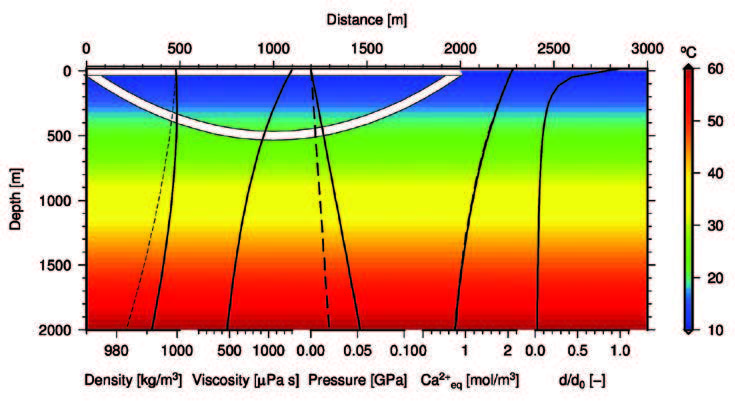Fracture evolution in soluble rocks: From single-material fractures towards multi-material fractures
DOI:
https://doi.org/10.3986/ac.v46i2-3.5135Keywords:
soluble rock, single fracture, dissolution and precipitation, inception horizonAbstract
We employ a numerical model describing the evolution of secondary porosity in a single fracture embedded in soluble rock (limestone, gypsum, and anhydrite) to study the evolution of isolated fractures in different rock types. Our main focus is three-fold: The identification of shallow versus deep flow paths and their evolution for different rock types; the effect of precipitation of the dissolved material in the fracture; and finally the complication of fracture enlargement in fractures composed of several different soluble materials. Our results show that the evolution of fractures composed of limestone and gypsum is comparable, but the evolution time scale is drastically different. For anhydrite, owing to its difference from calcite in the kinetical rate law describing the removal of soluble rock, the evolution is even faster. Precipitation of the dissolved rock due to changes in the hydrochemical conditions can clog fractures fairly fast, thus changing the pattern of preferential pathways in the soluble aquifer, especially with depth. Finally, limestone fractures coated with gypsum, as occasionally observed in caves, will result in a substantial increase in fracture enlargement with time, thus giving these fractures a hydraulic advantage over pure limestone fractures in their competition for capturing flow.
Key words: soluble rock, single fracture, dissolution and precipitation, inception horizon.
Odvisnost kraškega razvoja razpoke od vrste in zaporedja vodotopnih kamnin, skozi katere poteka
Z numeričnim modelom smo raziskovali razvoj sekundarne poroznosti v enodimenzionalni razpoki v apnencu, sadri in anhidridu. Cilji raziskav so bili: 1) ugotoviti razlike med razvojem plitvih in globokih razpok v različnih kamninah; 2) oceniti učinek morebitnega izločanja enega od mineralov v razpoki in 3) dinamika rasti razpoke, ki gre skozi plasti različnih kamnin. Rezultati kažejo na primerljiv razvoj razpok v apnencu in sadri, pri čemer je čas razvoja v obeh kamninah precej različen. V anhidridu je zaradi drugačne kinetike raztapljanja razvoj še hitrejši. Izločanje ob spreminjajočih se geokemičnih pogojih lahko hitro zamaši razpoke in posebej v večjih globinah spremeni poti razvoja mreže kraških prevodnikov. V primeru, ko so razpoke v apnencu prekrite s plastjo sadre, kar v naravi pogosto opažamo, je hitrost širjenja najhitrejša, kar daje vodnim potem vzdolž takih razpok izrazito primerjalno prednost pri zajemanju razpoložljivega toka.
Ključne besede: vodotopne kamnine, enostavna razpoka, raztapljanje in izločanje, incepcijski horizont.
Downloads

Downloads
Published
How to Cite
Issue
Section
License
Authors guarantee that the work is their own original creation and does not infringe any statutory or common-law copyright or any proprietary right of any third party. In case of claims by third parties, authors commit their self to defend the interests of the publisher, and shall cover any potential costs.
More in: Submission chapter




